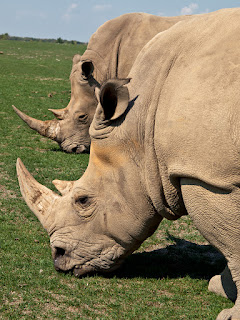I get the opportunity to see some amazing creatures when I travel to the locations where we run our International workshops. Africa is one of those places that has some of the worlds most recognizable animals... the white rhinoceroses is one of those creatures.
Periodically I am going to post some "Species Spotlights" as more of an education post to help inform you of some of the worlds great animals.
Today's Species Spotlight - The White Rhinoceroses
 Both black and white rhinoceroses are actually gray in color. The term “white” or “black” refer to their lips instead of their color. The black rhino has a pointed upper lip, while its white relative has a squared lip. The difference in lip shape is related to the animals' diets. Black rhinos get most of their sustenance from eating trees and bushes. They use their lips to pluck leaves and fruit from the branches. White rhinos graze on grasses, walking with their enormous heads and squared lips lowered to the ground.
Both black and white rhinoceroses are actually gray in color. The term “white” or “black” refer to their lips instead of their color. The black rhino has a pointed upper lip, while its white relative has a squared lip. The difference in lip shape is related to the animals' diets. Black rhinos get most of their sustenance from eating trees and bushes. They use their lips to pluck leaves and fruit from the branches. White rhinos graze on grasses, walking with their enormous heads and squared lips lowered to the ground.White rhinos live on
Under the hot African sun, white rhinos take cover by lying in the shade. Rhinos are also wallowers. They find a suitable water hole and roll in its mud, coating their skin with natures own bug repellent and sun block. Rhinos have sharp hearing and a keen sense of smell. They may find one another by following the trail of scent each enormous animal leaves behind it on the landscape.
White rhinos have two horns, the foremost more prominent than the other. Rhino horns grow as much as three inches (eight centimeters) a year, and have been known to grow up to 5 feet (1.5 meters) long. Females use their horns to protect their young, while males use them to battle attackers.
The prominent horn for which rhinos are so well known has been their downfall. Many animals have been killed for this hard, hair-like growth, which is revered for medicinal use in
The white rhino once roamed much of sub-Saharan
Come with the Photographer's Lounge as we go and see the white rhino when we visit Africa in 2013. In 2013 our plans to visit Africa are listed below. Check out these tours where the white rhino still live.
Tanzania with Rick Sammon in April of 2013
Namibia in April of 2014
Tanzania with Denise Ippolito in May of 2014
No comments:
Post a Comment